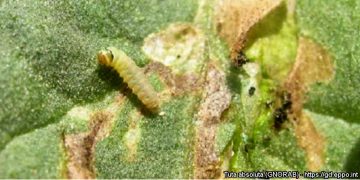At present, the prevention and control of T. absoluta is still dominated by chemical insecticides; however, the use of these products in some geographical areas has led to T. absoluta gaining increased levels of resistance. Moreover, the increased application of chemical insecticides is exerting a significant impact on the ecological environment. Consequently, there is a critical need to identify alternatives to chemical protocols for the prevention and control of T. absoluta; this coincides with a strong emphasis on the rapid development of biological control technology for global agricultural production.
Trichogramma species belongs to Trichogrammatidae family and the Hymenoptera order. As a parasitoid wasp that preys on eggs, many species of Trichogramma are considered as effective natural enemies for T. absoluta. Previous studies have shown that Trichogramma brassicae, Trichogramma evanesceus, Trichogramma pretiosum and Trichogramma bactrae all exhibit the ability to control T. absoluta. However, these species of Trichogramma are only distributed in certain areas of China. In contrast, Trichogramma ostriniae, Trichogramma chilonis and Trichogramma dendrolimi are the three most widely distributed and highly developed species of Trichogramma species that are native to China. These three species of Trichogramma have been widely applied in the prevention and control of a range of Lepidoptera pests, including Spodoptera frugiperda (Lepidoptera: Noctuidae), Ostrinia furnacalis (Lepidoptera: Crambidae) and Semiothisa cinerearia (Lepidoptera: Geometridae), and have achieved good levels of control. Over the last 2 years, field investigations have proven that these three species of Trichogramma exhibit a high rate of natural parasitism in areas affected by outbreaks of T. absoluta. The rate of natural parasitism attributed to T. ostriniae in some areas of China has exceeded 4.60% (unpublished data, field investigation carried out by the Green Prevention and Control Laboratory of Agricultural Pests of Yunnan Agricultural University), while Oliveira et al. detected in field experiments that the highest rate of natural parasitism exhibited by T. pretiosum was only 2.50%. Therefore, these groups of Trichogramma possess significant potential for the biological control of T. absoluta. However, this possibility has yet to be fully investigated.
Different species and strains of Trichogramma have been shown to exert differential control effects on target pests, therefore it is necessary to investigate the development, reproduction and control effects of different species and strains of Trichogramma on specific target pests. Life tables are an important tool for investigating the ecology of insect populations and the management of pests. These research tools can help researchers to accurately predict the growth of pest populations, coordinate the timing of control strategies in integrated pest management strategies and determine a number of population parameters, including the survival, development, longevity and fecundity of target pests under different environmental conditions. However, traditional forms of the insect life table tend to ignore changes in individual males and aging, making it impossible to accurately describe specific life parameters in an insect population, such as survival, reproduction and feeding rates. Age-stage two-sex life tables represent a significant improvement on traditional life tables by avoiding the problems associated with aging and individual males. Age-stage two-sex life tables not only consider age differences and the age differentiation of insects in significant detail, they also consider differences between female and male insects and the importance of male individuals within a given population. Many parasitoids, such as Trichogramma achaeae, Nasonia vitripennis and Diadegma insulare, have been analyzed by age-stage two-sex life tables to characterize their parasitic potential. However, age-stage two-sex life tables have not yet been used to investigate the parasitic effects of Trichogramma on the eggs of T. absoluta. In addition, the ability of different parasitoid species to control their hosts under greenhouse cage conditions can also be used as a valuable screening tool. For example, Montemayor and Cave, Ovruski et al. and Xu et al. all used greenhouse cage conditions to evaluate the prevention and control potential of parasitic/predatory natural enemies. However, the prevention and control abilities of T. ostriniae, T. dendrolimi and T. chilonis on T. absoluta eggs have yet to be investigated in greenhouse cages. Analysis showed that the net reproductive rate (R0), gross reproduction rate (GRR) and intrinsic rate of increase (r) of Trichogramma ostriniae were the highest of the three species at 22.85, 32.58 and 1.31, respectively. In the presence of 10 eggs and under ideal conditions, T. ostriniae, Trichogramma chilonis, and Trichogramma dendrolimi produced 9451.04, 5199.56, and 1902.95 offspring, respectively. Following the release of T. ostriniae, tomato leaves incurred a damage index of 1 after the first week, while the number of T. absoluta reduced to 24.60 individuals by week 10 (8.75% of the control treatment).
Photo: EPPO (2024) EPPO Global Database. https://gd.eppo.int
Reference: iang, Z., Sun, Y., Zhou, S., Xiong, P., Zhang, J., Wu, D., Chen, G. and Zhang, X. (2024), An evaluation of the growth, development, reproductive characteristics and pest control potential of three Trichogramma species on Tuta absoluta (Meyrick) (Lepidoptera: Gelechiidae). Pest Manag Sci. https://doi.org/10.1002/ps.8338































